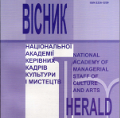РОМАНТИЗОВАНИЙ ХУДОЖНІЙ ОБРАЗ ЕСМЕРАЛЬДИ В ЄВРОПЕЙСЬКОМУ ЖИВОПИСІ ХІХ СТОЛІТТЯ
ROMANTICISED IMAGE OF ESMERALDA IN THE EUROPEAN PAINTING OF THE 19TH CENTURY
Author(s): Svitlana Valentynivna OborskaSubject(s): Visual Arts, 19th Century, History of Art
Published by: Національна академія керівних кадрів культури і мистецтв
Keywords: artistic image; Gypsy woman; Roma woman; fine art; painting; Victor Hugo; Notre Dame de Paris; Jali;
Summary/Abstract: The purpose of the article is to analyse the romanticised artistic image of Esmeralda in the works of nineteenthcentury artists – one of the key characters of Victor Hugo’s novel Notre Dame de Paris (1831) as a typical example of French literature of the Romantic period. This work is characterised by grotesqueness, hyperbole, conflict, and a tendency to dramatic moments in the plot construction, which is embodied in the figure of Esmeralda, a freedom-loving and charismatic Roma dancer. As a symbol of the two fundamental vectors of social development, which consisted in the struggle between good and evil, she captured the imagination of nineteenth-century artists, encouraging them to develop creatively and convey their feelings through visual tools in a romantic and realistic way. To this end, the following research methods were used: the historical method, which allowed to conduct study in accordance with the period of writing the novel and the works of art; the comparative method for comparing works of art united by a common storyline; the art historical analysis for establishing a number of stylistic and compositional features of each work. The scientific novelty is that for the first time a number of nineteenth-century paintings depicting the heroine of Notre Dame de Paris, Esmeralda, has been classified. The criterion for this selection was visual poetisation of the image of Esmeralda. Conclusions. The analysis of works by William-Adolphe Bouguereau, William Gale, Eugene Henry, Friedrich Kraus, Joseph van Lerius, Lionel Royer, Carl Steuben proves the attention of these and other artists to the figure of Esmeralda from Victor Hugo’s novel Notre Dame de Paris. In the analysed paintings, the image of Esmeralda reflects the key features of the romantic worldview: the cult of feelings, attention to inner experiences of an individual, fascination with demonic female images, among others. The pictorial interpretations of Esmeralda’s image by Romantic artists allow us to better understand the plot trends inherent in the Romantic period, and also to depict the external and internal beauty of women in the trends of Realism.
Journal: Вісник Національної академії керівних кадрів культури і мистецтв
- Issue Year: 2024
- Issue No: 1
- Page Range: 236-241
- Page Count: 6
- Language: Ukrainian

